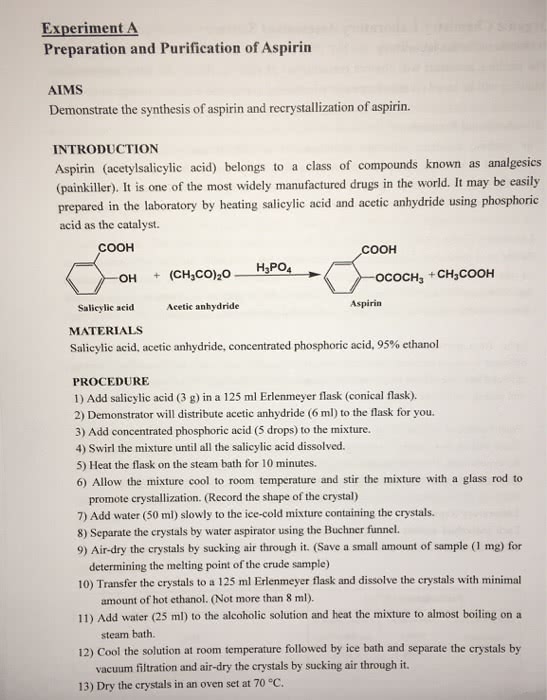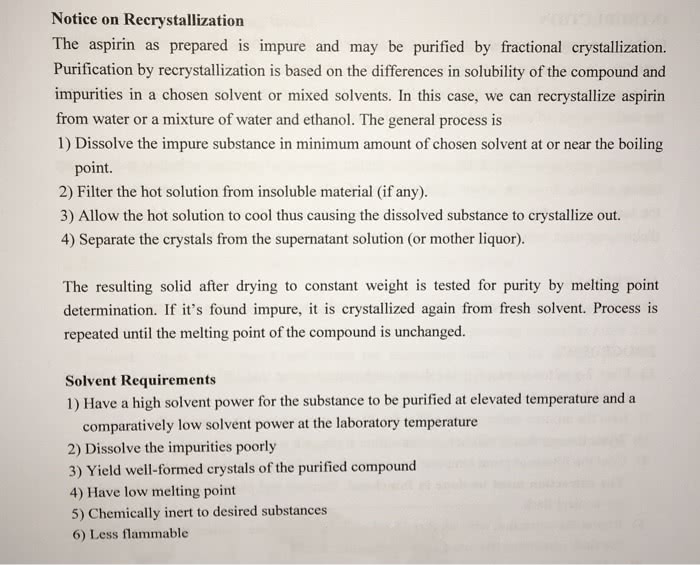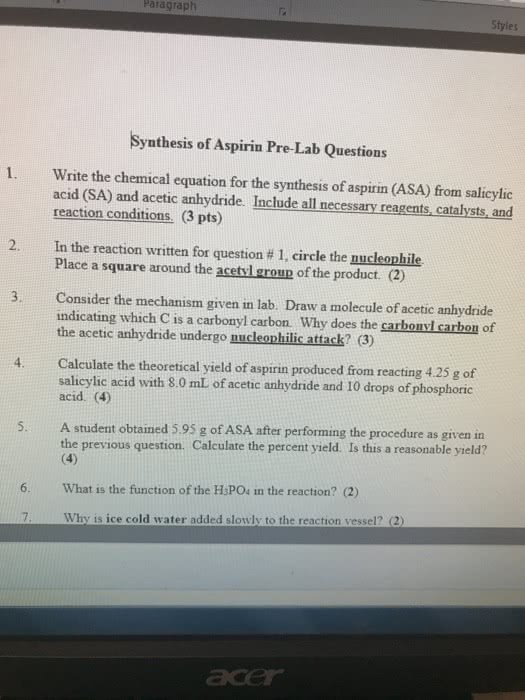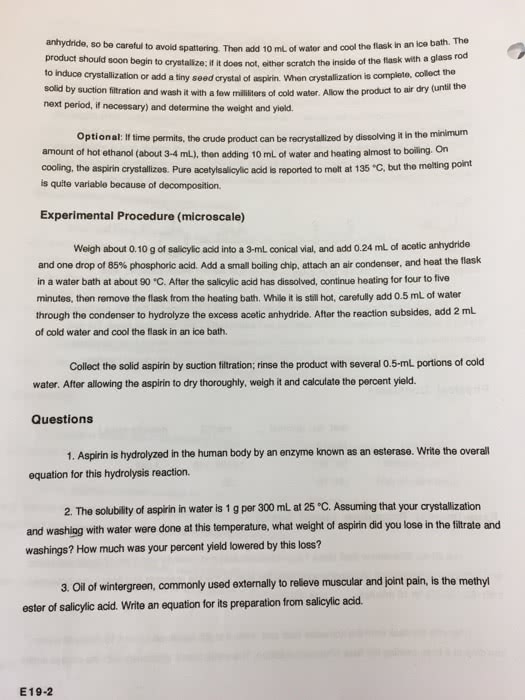Preparation of acetyl salicyclic acid (Aspirin) post-lab questions
1.)At the end of the reaction, you were asked to add ice-cold water to the reaction mixture. What do you think is the reason for this? Explain with chemical equations.
2.)How would the % yield of aspirin be changed if the final rinse of the solid product on the filter paper was done with warm water instead of ice-cold water?
3.)If you run a thin-layer chromatography for a mixture containing salicylic acid and aspirin using a 1:1 solvent mixture of ethyl acetate and hexane, which compound do you think would have more Rf value. Explain why? Bring in the structural features in your explanation.
summary Procedure of lab we did:
- Place approximately 0.300 g of salicylic acid in a tared empty 5 mL conical reaction vial. Record the actual weight of salicylic acid used. Using automatic pipet, add 0.8 mL of acetic anhydride (acetic anhydride vapors are very irritating-handle it carefully, in the hood). Add 2-3 drops of concentrated sulfuric acid using a dropper.
-Clamp the assembly so that the vial is partially submerged in the hot water. Turn on the magnetic stirrer. Once the water bath starts boiling, start timing the reaction. When the mixture has been allowed to react at 100 oC (the temperature of boiling water) for 15 minutes, you can consider the reaction to be complete. During the heating time, take about 20 mL of deionized water in a flask and chill it in an ice-water bath.
- After the reaction has gone on for 15 minutes, add very cautiously, drop by drop, 1 mL of deionized water to the reaction vial. At this point you should have a solution in your reaction vial. Remove the reaction vial form the hot water bath, add another 1-2 mL of DI water and let it stand at room temperature for few minutes. Then, detach the air condenser carefully and remove spin vane with forceps. Place the vial in a beaker and cool down to RT. During this time, the aspirin may begin crystallizing. If not, scratch the walls of the vial with a glass rod. Then, cool the vial in an ice-water bath.
- When the vial appears full of crystals, add about 3-4 mL of ice-cold DI water. Filter the aspirin using vacuum filtration (use Hirsch funnel). Leave the filtration setup in place for few minutes-this will draw air through the sample and will help dry aspirin.
Recrystallization of Aspirin:
- Transfer the rest of the crude aspirin to a 25 mL Erlenmeyer flask and do recrystallization using ethanol.
Purity of Aspirin:
- Using the melting point apparatus, determine the melting point of your crude aspirin and the recrystallized aspirin.
- To do FeCl3 test, get 4 test tubes. Place 1 mL of ethanol and 2 drops of 1% FeCl3 solution in each test tube. Add few crystals of salicylic acid to one test tube. Add few crystals of your crude aspirin product to the second test tube. In the thirst test tube, place a few crystals of your recrystallized aspirin. The fourth test tube will be your âblankâ. Shake each of the test tubes and record your observations.
Preparation of acetyl salicyclic acid (Aspirin) post-lab questions
1.)At the end of the reaction, you were asked to add ice-cold water to the reaction mixture. What do you think is the reason for this? Explain with chemical equations.
2.)How would the % yield of aspirin be changed if the final rinse of the solid product on the filter paper was done with warm water instead of ice-cold water?
3.)If you run a thin-layer chromatography for a mixture containing salicylic acid and aspirin using a 1:1 solvent mixture of ethyl acetate and hexane, which compound do you think would have more Rf value. Explain why? Bring in the structural features in your explanation.
summary Procedure of lab we did:
- Place approximately 0.300 g of salicylic acid in a tared empty 5 mL conical reaction vial. Record the actual weight of salicylic acid used. Using automatic pipet, add 0.8 mL of acetic anhydride (acetic anhydride vapors are very irritating-handle it carefully, in the hood). Add 2-3 drops of concentrated sulfuric acid using a dropper.
-Clamp the assembly so that the vial is partially submerged in the hot water. Turn on the magnetic stirrer. Once the water bath starts boiling, start timing the reaction. When the mixture has been allowed to react at 100 oC (the temperature of boiling water) for 15 minutes, you can consider the reaction to be complete. During the heating time, take about 20 mL of deionized water in a flask and chill it in an ice-water bath.
- After the reaction has gone on for 15 minutes, add very cautiously, drop by drop, 1 mL of deionized water to the reaction vial. At this point you should have a solution in your reaction vial. Remove the reaction vial form the hot water bath, add another 1-2 mL of DI water and let it stand at room temperature for few minutes. Then, detach the air condenser carefully and remove spin vane with forceps. Place the vial in a beaker and cool down to RT. During this time, the aspirin may begin crystallizing. If not, scratch the walls of the vial with a glass rod. Then, cool the vial in an ice-water bath.
- When the vial appears full of crystals, add about 3-4 mL of ice-cold DI water. Filter the aspirin using vacuum filtration (use Hirsch funnel). Leave the filtration setup in place for few minutes-this will draw air through the sample and will help dry aspirin.
Recrystallization of Aspirin:
- Transfer the rest of the crude aspirin to a 25 mL Erlenmeyer flask and do recrystallization using ethanol.
Purity of Aspirin:
- Using the melting point apparatus, determine the melting point of your crude aspirin and the recrystallized aspirin.
- To do FeCl3 test, get 4 test tubes. Place 1 mL of ethanol and 2 drops of 1% FeCl3 solution in each test tube. Add few crystals of salicylic acid to one test tube. Add few crystals of your crude aspirin product to the second test tube. In the thirst test tube, place a few crystals of your recrystallized aspirin. The fourth test tube will be your âblankâ. Shake each of the test tubes and record your observations.





